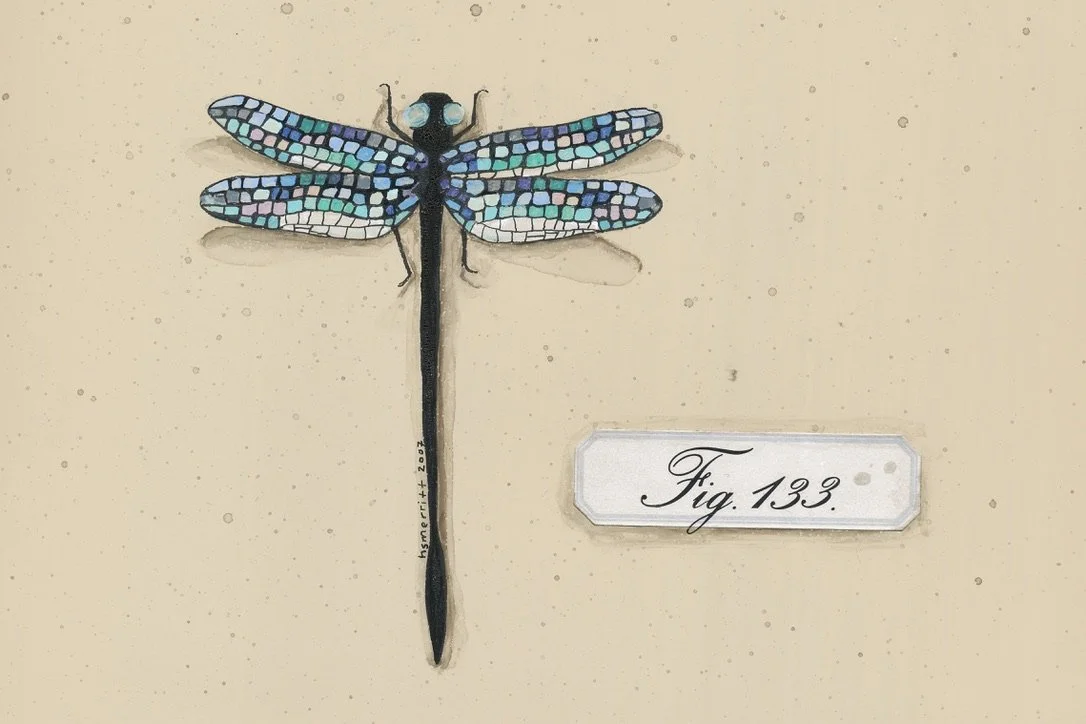 Image 1 of 2
Image 1 of 2

 Image 2 of 2
Image 2 of 2



Specimen No. 133. Alpine Tile Dancer
Specimen No. 133
Name: Alpine Tile Dancer | Callothemis vitrivaga borealis
Collected By: Hjörleif M. Sørensen
Date of Collection: 22 July 1956
Locality: Kerlingarfjöll geothermal shelf, Icelandic Highlands
Catalog No. FD - 07 - 133
Field Memoir – Sørensen, unpublished pages —
“I had nearly packed the net. The sulfur shelf was windless that morning—steam rising sideways, not up. The air smelled of warm stone and dried eggs. I’d been out four days with nothing to show but ash-stained boots and a ruined water gauge. No insect in its right mind should’ve been flying through that heat. But then, just above a cracked basalt spill, it hovered.
Still as a coin in ice water.
At first I thought it was broken glass catching the sun—four wings outstretched, barely moving. Not clear, not colored, but both: a cold geometry of blue and silver segments, each one lit differently. They didn’t pulse like a dragonfly’s usually do; they shifted, almost clicked—like windowpanes adjusting in a breeze.
Its body was long, stiff, too slender for the genus. Obsidian-dark with a dusting of blue, like a glacier that had melted and re-frozen wrong. The eyes were the strangest part—matte, unreadable. They didn’t shine. They took the light in and gave nothing back.
It didn’t flee when I stepped closer. I moved slow, not out of caution, but respect. It wasn’t fragile—it was deliberate. It hovered in one place, then tilted vertically, rose a few centimeters, and settled again like a weightless hinge.
I netted it without resistance. No struggle. It simply folded in. Wings flat, abdomen aligned. Like it had done this before.”
Note: High quality archival glicée print on acid-free paper, a method that creates fine art reproductions with exceptional color accuracy and longevity. Pigments-based inks are designed to resist fading and discoloration and capture the finest details and subtle color variations with great precision.
Housed in a 4×6” crystal-clear acrylic specimen block, its 1” depth allows freestanding display. Each piece is designed to exhibit on desk or shelf.
Fly Design uses a practice known as entonology — the study of fictitious insects — to reimagine the natural world through scientific storytelling and poetic design.
Specimen No. 133
Name: Alpine Tile Dancer | Callothemis vitrivaga borealis
Collected By: Hjörleif M. Sørensen
Date of Collection: 22 July 1956
Locality: Kerlingarfjöll geothermal shelf, Icelandic Highlands
Catalog No. FD - 07 - 133
Field Memoir – Sørensen, unpublished pages —
“I had nearly packed the net. The sulfur shelf was windless that morning—steam rising sideways, not up. The air smelled of warm stone and dried eggs. I’d been out four days with nothing to show but ash-stained boots and a ruined water gauge. No insect in its right mind should’ve been flying through that heat. But then, just above a cracked basalt spill, it hovered.
Still as a coin in ice water.
At first I thought it was broken glass catching the sun—four wings outstretched, barely moving. Not clear, not colored, but both: a cold geometry of blue and silver segments, each one lit differently. They didn’t pulse like a dragonfly’s usually do; they shifted, almost clicked—like windowpanes adjusting in a breeze.
Its body was long, stiff, too slender for the genus. Obsidian-dark with a dusting of blue, like a glacier that had melted and re-frozen wrong. The eyes were the strangest part—matte, unreadable. They didn’t shine. They took the light in and gave nothing back.
It didn’t flee when I stepped closer. I moved slow, not out of caution, but respect. It wasn’t fragile—it was deliberate. It hovered in one place, then tilted vertically, rose a few centimeters, and settled again like a weightless hinge.
I netted it without resistance. No struggle. It simply folded in. Wings flat, abdomen aligned. Like it had done this before.”
Note: High quality archival glicée print on acid-free paper, a method that creates fine art reproductions with exceptional color accuracy and longevity. Pigments-based inks are designed to resist fading and discoloration and capture the finest details and subtle color variations with great precision.
Housed in a 4×6” crystal-clear acrylic specimen block, its 1” depth allows freestanding display. Each piece is designed to exhibit on desk or shelf.
Fly Design uses a practice known as entonology — the study of fictitious insects — to reimagine the natural world through scientific storytelling and poetic design.